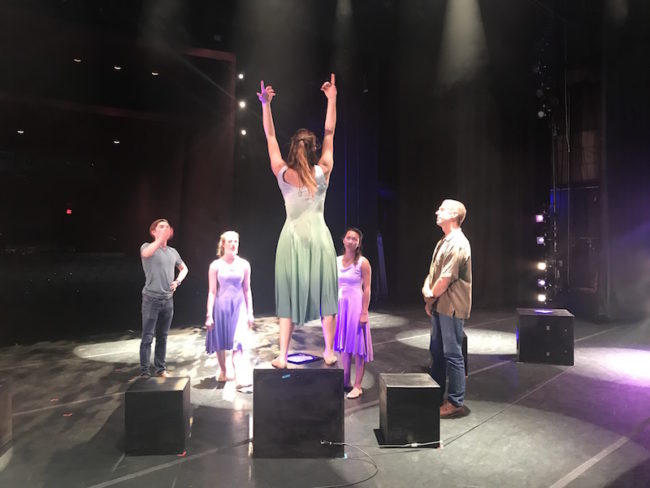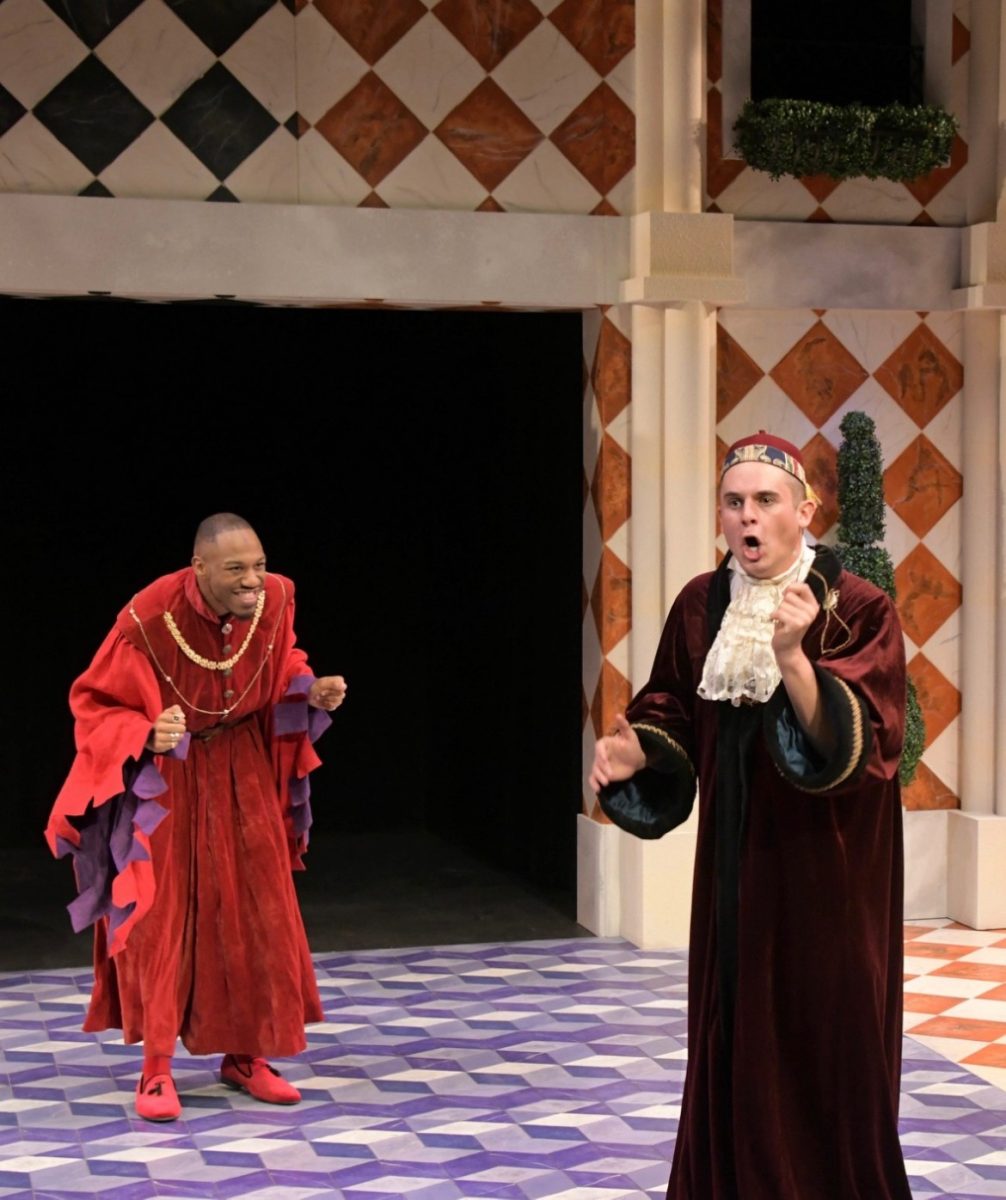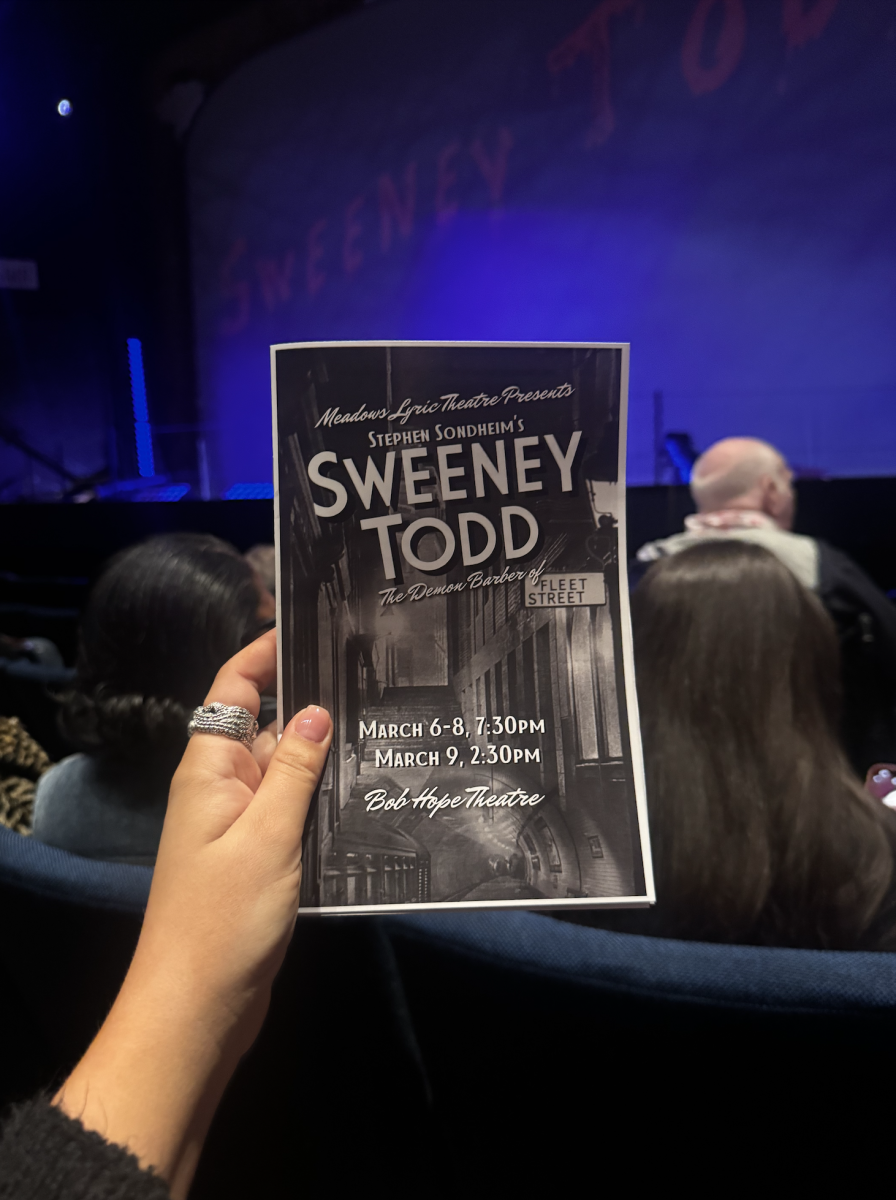In the Meadows School of the Arts, it’s not uncommon to see artists installing sculptures in the atrium, hear opera singers rehearsing in the Hope Lobby, or almost trip over a dancer as they stretch out on the floor before a rehearsal. With this array of artistic expression constantly on display, the sight of a student pushing around huge black boxes with LED light inserts on a rolling cart would not be all that shocking, until you realize that that student is not a studio artist or involved with set design, but a dance major.
Aaron D’Eramo, a senior dance and anthropology major who has received awards of distinction for both of these fields, has been working since the beginning of last semester on his senior dance capstone project, a piece of choreography that was featured in the spring 2019 Senior Dance Concert, “Reflections,” this past Friday and Saturday at the Bob Hope Theatre in the Meadows School of the Arts. D’Eramo brought together SMU students from the English, theatre and dance departments to bring his vision to fruition. I sat down with D’Eramo to learn more about his choreographic work, how exactly he’ll be using these intriguing set pieces in his dance, and his reaction now that his capstone journey has come to an end.
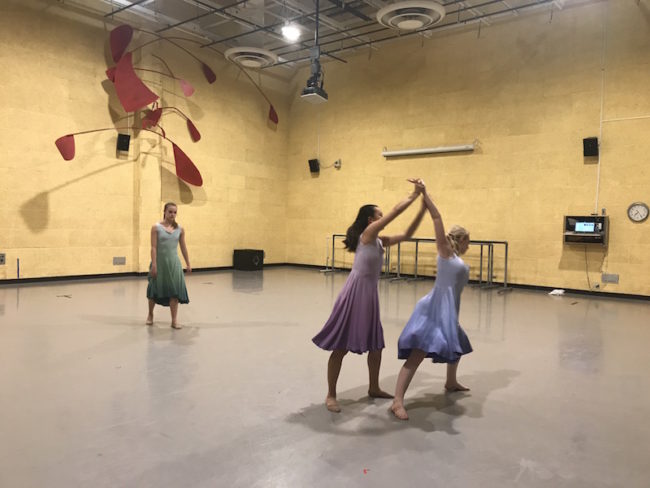
The Theme
Q: When did you first start thinking about your Senior Dance Concert piece, and what was your inspiration for the piece?
A: Probably October of senior year. I wanted to take a notion from history and kind of develop it and modernize it, so I looked at the three Boeotian Muses in classical Greek tradition, Melete, Mneme and Aoide. I see the Muses as embodiments of human culture, and everything that makes us artistically human, and I thought, this is perfect, the dancers can represent humanity, and more specifically the human consciousness.
Q: Can you explain how your piece ties into the concert’s theme of “reflections?”
A: What happened during the process was I started choreographing, and I realized that the piece wouldn’t really be about our species, but it would be about our conscious minds. When we were having our big meeting about what the overall theme for the concert would be, we decided on “reflections,” because all of our pieces are highly introspective. So I sat there thinking, how is my piece reflective? How is it introspective? And I thought, well, these three Muses, represented by the three dancers in my cast, represent three different points of consciousness, and the piece kind of developed into an introspective battle between these characters. You have these three different points of consciousness fighting with each other in a way. By the end of the piece, the three consciousnesses come together and find a more common ground.
https://www.instagram.com/p/Bwp85BOBUeq/
Q: Can you explain the title of your piece?
A: The title of the piece is called “Coalescence,” because it is about these three points of consciousness coming together, to coalesce into one identity. It basically represents a person coming to peace with all of the different voices in their head, and all of the different perspectives that you hold.
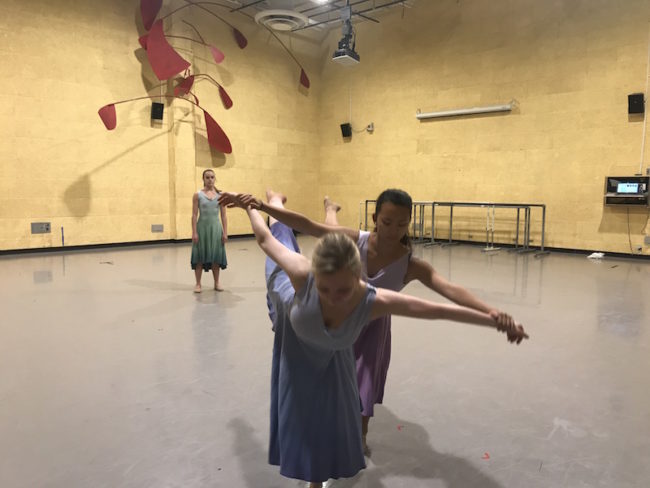
The Set
Q: Can you explain the purpose behind the scenic element that you have in your piece? I understand that your dance includes several boxes on the stage, and that some of them light up internally.
A: Really, I am using the boxes in various ways. The three big boxes that have the lights inside, I initially used those as a level change, and to represent the three different launching points for the Muses in the beginning of the piece.
With the small boxes, I wanted to have those props on stage because they are easily manipulated. The whole second section, which is accompanied by the poem “A Mirror’s Musings” by Temi George, involves the dancers manipulating the placement of the boxes, therefore level change, therefore changes of direction, therefore energy shifts. Really I’m using them in a lot of different ways, because I really wanted to transcend the level of the stage. For example, there is a point in the piece when one of the dancers is walking along on the top of the boxes, and the other dancers are pulling the boxes out from under her feet as she progresses forward. I wanted this effect to give the dancer an ethereal quality, as if she is transcending reality.
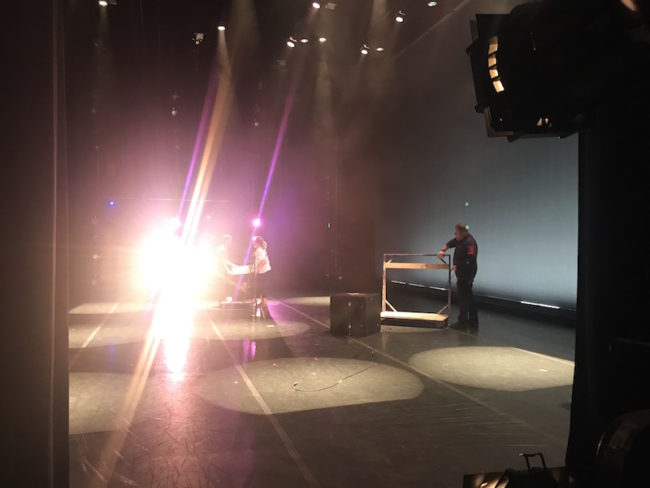
Q: Can you speak to the technicalities of getting the boxes stage ready, as far as aesthetic and functionality are concerned?
A: So Christopher Dolder, who is my faculty advisor for this piece and the chair of the dance department, actually built these boxes for the Burning Man festival. He was like, well you’re thinking about cubes, and I have these cubes that shoot beams of light out of them. And I was like yes. I want them. They were fantastic at first, but then I was looking at them, and they had sand all over them still from Burning Man, so I took them into the set shop and cleaned them up, scrubbed them down, sand papered all of them, and repainted them. But then we had issues getting the lights into the boxes, so we had to take them apart again and reconfigure the inside to accommodate the lights. And then of course, the lights have to be charged every day, so I lugged the boxes to outlets every day to charge them.
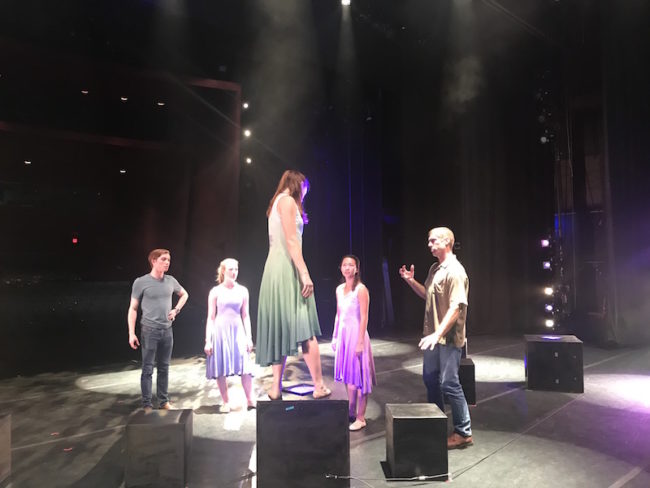
The second issue was how to control the lights while the dance is going on, because the lights have remotes, but you have to be closer than ten feet away to control them, so I wouldn’t have even been able to control them from the wings, because they would have been too far away. I toyed with the idea of having the dancers command the lights using the remotes while they’re dancing, but I quickly threw that idea out, because it would have messed too much with the movement. Then speaking with Rose Cobey, my lighting designer, she suggested that we hook the lights up to the mainframe, that way we would be able to do more intricate changes with the lighting, they could fade in, fade out, and change colors, and the dancers wouldn’t have to worry about it then. So we used DMX cables and wired them from the stage to the mainframe that way. It took some time to figure out the lighting in the boxes, but I’m very happy with the finished product.

The Poem
Q: What made you choose to commission an original poem to be included as an auditory element in your dance? How was the creation process for this component of your project?
A: So in October, I started my ideas, and in November, I started talking to the classics department, doing research, I started talking to the English department, and I was like, I want to write a poem and these are my ideas, and I started really honing in my ideas with various professors. Dr. Brownderville, in the English department, actually said that he had a student that would be really interested in this, and he recommended Temi George, who is an English major here and a creative writer.
It’s just been an amazing collaboration. We met probably five times, and it was a full collaboration. Temi would write up drafts and send them to me, and then we would exchange ideas. Her poem was greatly influenced by my movement that she saw, but then I also created so much movement off of the poem. This poem and the piece are one and the same essentially. And the words of the poem are meant to elicit a kinesthetic response, both in the dancers and in the audience.
Below is the poem recording, as it was presented during the Senior Dance Concert.
Q: In addition to having the poem commissioned, I understand that you also recorded SMU theatre majors reading the poem aloud, and then you mixed the three voices into an abstracted recording. Can you elaborate on this process?
A: I worked with Ellie Gilbert, Michael Garcia and Shannon Gennette, who are all BFA theatre majors here. I wanted to collaborate with actual voice actors, because I knew they would bring a level of emotion that would pull the audience in and guide the audience in their interpretation of the work. This was a great collaborative experience too, because I was able to fill them in on my piece, and Temi was there too to guide them in their reading. I wanted Temi to be there to give them specific directives on how exactly to read the poem, because you know the way a poem is read can significantly impact its interpretation by the audience.
Also, I chose to use three different voices to represent the three different points of consciousness that the Muses are representing. The voices begin in chaos, with a bunch of overlapping, but by the end it’s more unified, so this parallels the overarching narrative of the piece. I used Audacity, which is like the PC version of GarageBand, to cut all of the recording together. It took me several hours because to be honest I’m not that good with the program, but I’m really proud of the way it turned out.
The Music
The first section of D’Eramo’s dance was to the song “Pyramid Song” by VOCES8.
Q: Besides the poem, your dance also includes two sections to music, one before and one after the poem section. Can you explain why you chose the songs that you did?
A: The first piece of music is “Pyramid Song” by VOCES8. They’re an amazing a cappella group. I love all of their music, but I came across this reworking of Radiohead’s “Pyramid Song,” and the lyrics are beautiful and ethereal, and this dance has an overall ethereal quality to it, so I thought it would work well. At the end of the poem, the music breaks into “The Dharma at Big Sur, Part 1: A New Day ” by John Adams. I love John Adams as a composer. It’s a shame that we’re constrained to 10 minutes for this capstone project, because this song in its entirety is 14 minutes, but I’m using only two minutes of it, so editing that was very difficult, choosing just two minutes of that song. For me, the electronic violin section in this music had the sense of wholeness, of unity, that I wanted to portray in the end of the piece, so I went with that.
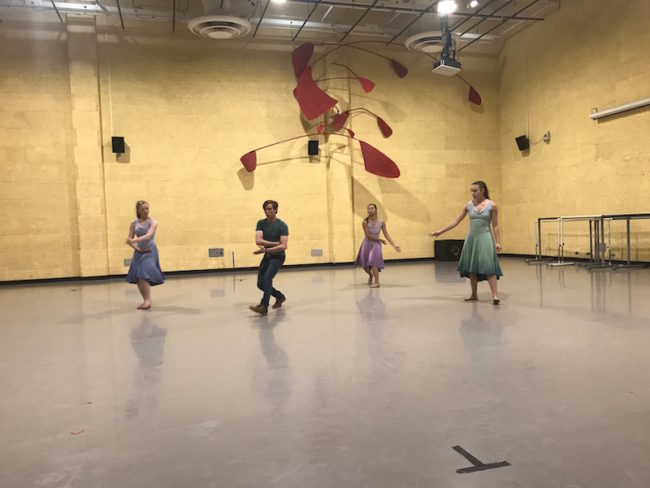
The Costumes
Q: Costuming is obviously a huge part of the final look of the dance. How did you decide on what the dancers would wear to emulate your theme?
A: Well I wanted to go for the Grecian look because of the Muse thing, but I didn’t want it to be too obvious. I worked with Genie Stallings, who heads up the costuming department for Meadows, and she showed me several different options for the dresses. She showed me a few that were really Grecian, like basically togas, and I thought that that would be too literal. The dance itself is an abstraction of this classical theme, so the costumes for me needed to be an abstraction of the idea as well.
I also chose these specific dresses because they are lighter at the top, almost white, and more saturated in color at the bottom. So when you put the lights on them, I am actually able to manipulate the colors of the dresses with the different lighting colors on the stage. The dresses are three different colors, representing the three different Muses, but when they are put in a colored light, they all appear to be pretty much the same color, so this helped the coalescence image at the end of the dance. The dancers come together at the end of the dance and cease to be very independent voices, and their costumes are able to reflect that as well.
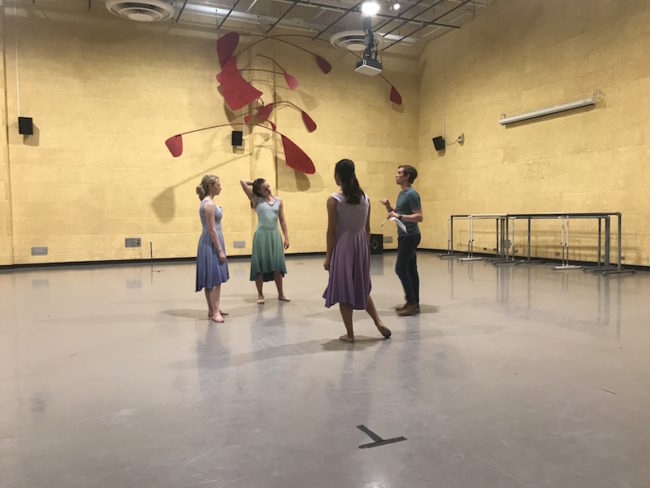
The Dance
Q: As far as the actual choreographic process went, how did you choose to run your rehearsals? Was it a more collaborative experience with the dancers, or did you present a specific movement lexicon for them to emulate?
A: There were two parts. For the first part, I generally have to have my movement ready to teach the dancers before going into a rehearsal. I’m a big researcher with my choreography, and my movement is supposed to embody those ideas, so I go into the studio and I make sure that my movement is exactly what I want it to be.
Now it does turn a little more collaborative in the poem section of the piece, because I would give them little cues or ideas from the poem and I wanted to see their interpretation of those prompts. So it was kind of a mixed process, but in general, I had the movement prepared and then taught it to the dancers. I also gave the dancers specific words and phrases, which I chose based off of my research on the Muses, which dictated the movement lexicon I created for them. These words both helped me to shape my choreography, and gave the dancers a more specific direction as they performed the work.
Also, I have to give credit to my amazing cast. They are sponges; they absorb choreography so quickly. I would give them over two minutes of choreography every rehearsal, which is a lot, and they would just eat it up. I also made a lot of changes to my choreography throughout the process, and they were so receptive and quick on their feet, both figuratively and literally.
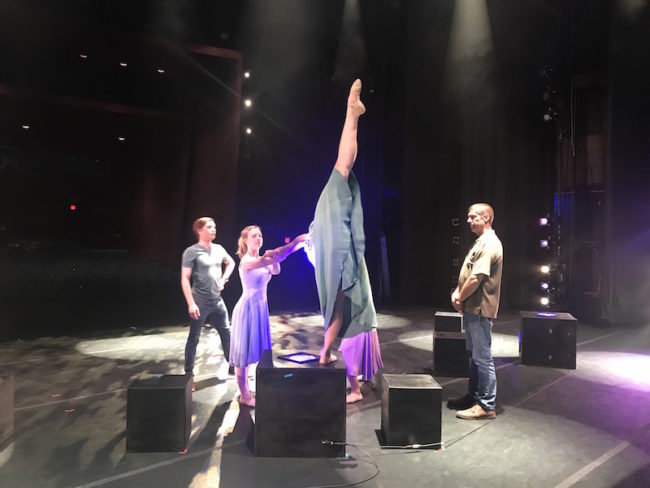
The End
Q: Now that Senior Dance Concert is over and you’ve seen your piece performed on the stage, do you think that your ideas translated the way you wanted them to?
A: Speaking with audience members after the show, several of them said that my piece took them on a journey, and that was great to hear because that’s really what I was going for. I wanted to take the audience out of the theatre, and evoke a sort of out of body experience, and I also heard from people that it felt otherworldly, which was very reassuring, because then the ethereal nature of the piece came across. The piece is an abstraction, so really the audience could interpret it in many ways, and that is fine with me, so the fact that they had a general feeling of an otherworldly atmosphere, I’m very happy with this outcome.



